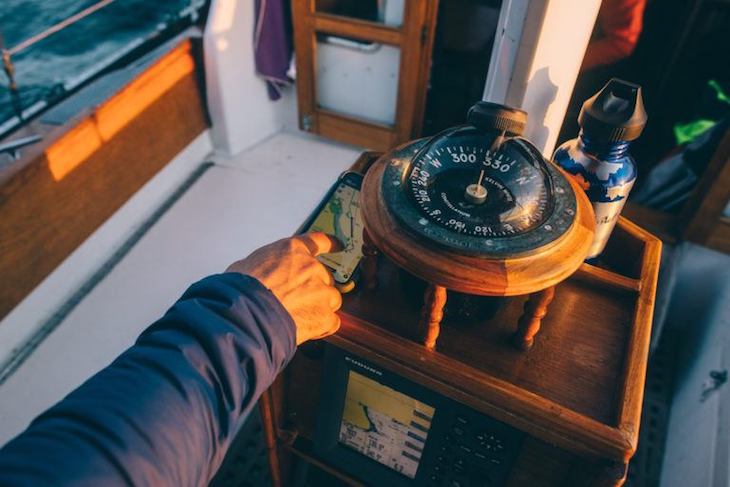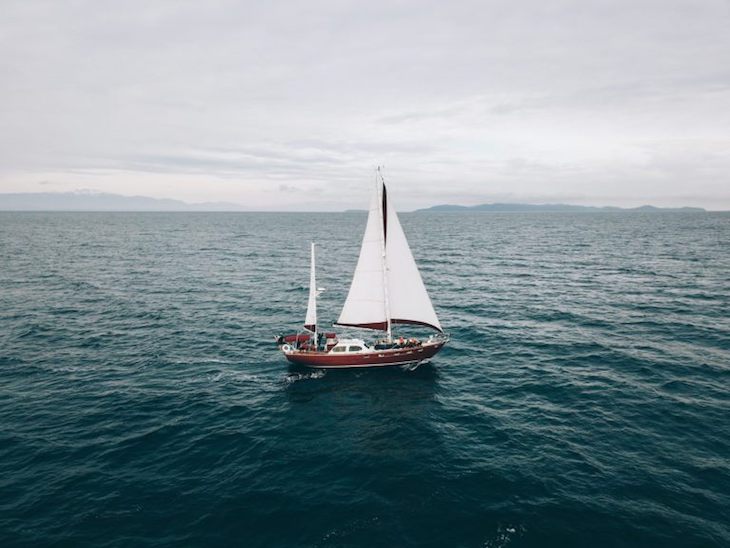Part Two: Sail to Ski British Columbia
In Part Two we learn more about the route, the boat, the gear, and the food that were central to one of the first sail-to-ski trips along the British Columbia coast

By Andy Cochrane
The Route: Chronologically speaking, our first hurdle was crafting a route that balanced safety with efficiency, and included a few necessary conditions like stopping at a port with a Customs office. For the most part we did this with a divide and conquer strategy, each investigating in the areas that we had more experience. Ben focused on sailing charts, wind patterns, and possible challenges like tidal rapids, while I focused on slope angles and aspects, nearby logging roads, and snow conditions.

Paired together, we wove a path from his home port of Bainbridge Island north through the San Juan Islands, across the Strait of Juan de Fuca, an overnight on Vancouver Island at Nanaimo, across the Strait of Georgia, winding up the Jervis Inlet and through the Malibou Rapids to Princess Louisa. At the end of the inlet is a provincial park with a short trail to Chatterbox Falls. We would tie up the boat at the dock there, then snake our way up a series of unmaintained trails, crawling under, over, and around hundreds of down trees to reach snowline. The crux came at the end, when we had a skin carefully through a gully that was prone to sliding. Once through, we’d reach the ridge and setup basecamp, with dozens of ski lines surrounding our tent outpost.

The Boat: For those looking to replicate our trip, you have two questions to answer. First, identifying a sailboat able to fit the crew and in good enough repair to make the journey. Second, convince the captain of said boat that an international sail to ski adventure is a good idea. Fortunately for me, both were relatively easy. Ben is one of my closest friends and owns True, a double-masted 44-foot ocean-going ketch, perfect for our 8-day trip. We stowed skis on deck and camping gear in small holds, saving space for people and personal bags.
Below decks True is craftily designed with a raised pilothouse, dinette that converts to a double bunk, small galley and salon, front v-berth, and a head with toilet and shower that we also used for wet gear. At the center of the boat is a small wood stove, for staying warm at night. The only catch was that bunk space only accommodated six, so Wyatt and I were relegated to sleeping on deck, enjoying stars and an occasional bit of rain.
The Gear: When it comes to gear, I have two main philosophies. First, less is almost always more. Bringing too much stuff is not only a nuisance, but will also wear you out and eventually become a safety problem. Second, try to find generalist gear – stuff that works in a variety of situations. Both of these apply here. Because we couldn’t guarantee specifics about the snow quality, the week-long weather forecast, or what curveballs we’d run into along the way, it was paramount that we packed the right stuff.
With that in mind, I opted to bring along lightweight bibs and rain jacket from Helly Hansen, that would double as my ski outerwear. Paired with an Oden Puffy and wool baselayers, this was good enough to keep me dry on the wet climb and warm while ski touring. Strapped to my pack were a pair of Faction Prime skis with Dynafit bindings, providing a good all-around setup that wouldn’t add unnecessary weight on the arduous hike uphill. At basecamp we relied on Stormking expedition tents and a suite of Reactor and Windburner stoves, both made by MSR. These are products that I’ve trusted for years in the mountains, because they’ve kept me dry and fed on dozens of week-long projects.

The Food: We found it easiest to divide the found into sections – the sail, the hike, and skiing – to simplify meal planning and caloric needs. On the boat we ate relatively lavishly, with fresh vegetables, warm soups, and carb-loading meals. On the hike we ate dozens of quick snacks, so that we could keep a steady pace and avoid the danger that comes with rain and 35 degree temps. While winter camping above snow line, we shared Good To-Go dehydrated meals, made tea to help warm core temperatures, and treated ourselves to more than a few bars of chocolate.

Check out our next Expedition: How to Bikepack During a Heatwave
